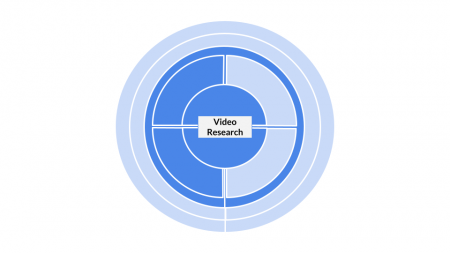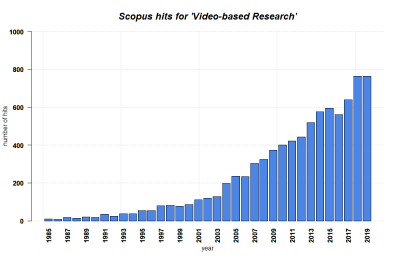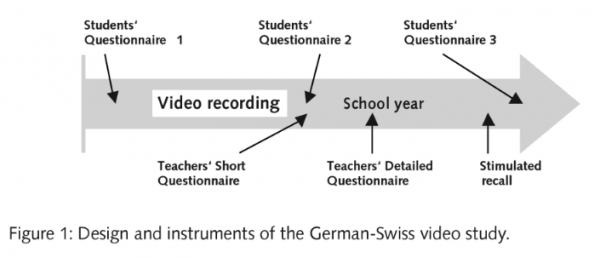Difference between revisions of "Video Research"
| Line 35: | Line 35: | ||
== Strengths & Challenges == | == Strengths & Challenges == | ||
| − | * The biggest strength of the method stems from the nature of the data. '''Video material can be slowed down, stopped, rewound, re-watched and stored for a long time.''' This makes video-based research "(...) a tool for social scientists to observe phenomena that are too complex to be noticed by the naked eye." (Janík et al. 2009, p.7). The researchers are not limited to what they were able to note down during the event itself, but can assess everything that happened as often as they like (1, 4, 6). At the same time, this complexity can be reduced to a specific aspect of interest for a first analysis, after which the researchers can come back to the data at any later point for further inquiries (2). Long-time comparisons are also possible if similarly taped videos are produced over a span of time. Several researchers - potentially from different disciplinary backgrounds - can code and analyze the material at once, and regularly discuss their insights and exchange perspectives which can lead to the emergence of new ideas and analytic categories (1, 3, 4, 6). This increases inter-coder reliability without having to determine a narrow focus of the research prior to the data collection (3, 4). In addition, the data format facilitates the communication of results since exemplary scenes or images can be taken from the video (4). | + | * The biggest strength of the method stems from the nature of the data. '''Video material can be slowed down, stopped, rewound, re-watched and stored for a long time.''' This makes video-based research "(...) a tool for social scientists to observe phenomena that are too complex to be noticed by the naked eye." (Janík et al. 2009, p.7). The researchers are not limited to what they were able to note down during the event itself, but can assess everything that happened as often as they like (1, 4, 6). At the same time, this complexity can be reduced to a specific aspect of interest for a first analysis, after which the researchers can come back to the data at any later point for further inquiries (2). Long-time comparisons are also possible if similarly taped videos are produced over a span of time. Several researchers - potentially from different disciplinary backgrounds - can code and analyze the material at once, and regularly discuss their insights and exchange perspectives which can lead to the emergence of new ideas and analytic categories (1, 3, 4, 6). This increases inter-coder reliability without having to determine a narrow focus of the research prior to the data collection (3, 4). In addition, the data format facilitates the [[Glossary|communication]] of results since exemplary scenes or images can be taken from the video (4). |
* '''The complexity of the respective situation as captured by the video material allows for both qualitative and quantitative analysis and the application of a range of different research questions and perspectives.''' Also, as mentioned before, qualitative and quantitative results can be integrated because of the rewatchability of the data. | * '''The complexity of the respective situation as captured by the video material allows for both qualitative and quantitative analysis and the application of a range of different research questions and perspectives.''' Also, as mentioned before, qualitative and quantitative results can be integrated because of the rewatchability of the data. | ||
| Line 44: | Line 44: | ||
* With a camera being present, the subjects / participants may act differently than they usually would (3, 4). | * With a camera being present, the subjects / participants may act differently than they usually would (3, 4). | ||
* Lastly, the act of videotaping individuals brings along moral implications of privacy and confidentiality that need to be addressed beforehand, e.g. by establishing an open relationship with the subjects of research and ensuring agreement on the usage of the video material (1, 3; see Normativity). | * Lastly, the act of videotaping individuals brings along moral implications of privacy and confidentiality that need to be addressed beforehand, e.g. by establishing an open relationship with the subjects of research and ensuring agreement on the usage of the video material (1, 3; see Normativity). | ||
| − | |||
== Normativity == | == Normativity == | ||
Revision as of 16:06, 9 April 2021
| Method categorization | ||
|---|---|---|
| Quantitative | Qualitative | |
| Inductive | Deductive | |
| Individual | System | Global |
| Past | Present | Future |
In short: Video Research extracts information based on video material of social interactions.
Background
In the beginning of the 20th Century, ethnographers made use of early video technology for so-called 'film studies' that had a focus on "human behavior and conduct, interaction and communication" (Janík et al. 2009, p.7; 1). Yet, video- or audio-taping was also often used merely to help produce more precise transcriptions of speech in qualitative research and to identify and describe the speaking individuals (4).
During the second half of the 20th Century, however, the rising availability and fidelity of video technology led to an increase of its usage and to advancements of the methodology. Being able to videotape events, such as classroom sessions, offered researchers new, rich possibilities of qualitative analysis compared to solely relying on taking notes and conducting interviews (1). At the same time, this deep insight limited in turn the potential sample size in the respective studies (4). So while purely qualitative approaches - focusing on single or small numbers of classes - had become a common form of educational analysis by the 1990s, they did not allow for generalizations that were necessary for changes in educational policies.
As a consequence, quantitative approaches in form of Video Surveys were introduced at the end of the 1980s (1, 4). The most notable research endeavor in this regard was the TIMSS Videotape Classroom Study in the 1990s (see Key Publications). This study relied on 'Video Surveys', which include bigger case numbers and which were made possible through improvements in multimedia computer technology (1, 4). They combine the potential for statistical analysis and thus more generalizable findings while maintaining the validity provided by the video technology. Due to the technological improvements during the last decades, video-based research was subsequently applied more often (1, 3, 6). Today, video-based methodologies are used mainly in educational research, often in the field of cross-national comparisons, but also in psychology and sociology (1, 4).
What the method does
Video-based research refers to "(...) research of social or educational reality based on analysis of video recordings" (Janík et al. 2009, p.7). Individual events, such as classroom sessions or cultural ceremonies, are recorded on video. The generated video footage then serves as the basis for the analysis of the respective situation. Video-based research is thus a method that includes both data gathering and data analysis (2). The video data is coded in a process similar to Content Analysis: the events happening in the video and the statements made by, for example, teachers and students are coded according to theory-led, pre-determined or inductively and iteratively developed categories (4). Often, additional data is adduced to provide contextual information (see Challenges).
The scope of the research may range from qualitative, unstructured, small-scale observations to more quantitative, large-scale, structured studies, depending on the research questions and theoretical approach (2). Quantitative approaches allow for the identification of trends and variations, while more qualitative approaches strengthen the understanding of prevalent phenomena (1). The possibility of combining both approaches is special about video-based research and enables researchers to quantitatively validate comprehensive qualitative findings (1, 4).
Strengths & Challenges
- The biggest strength of the method stems from the nature of the data. Video material can be slowed down, stopped, rewound, re-watched and stored for a long time. This makes video-based research "(...) a tool for social scientists to observe phenomena that are too complex to be noticed by the naked eye." (Janík et al. 2009, p.7). The researchers are not limited to what they were able to note down during the event itself, but can assess everything that happened as often as they like (1, 4, 6). At the same time, this complexity can be reduced to a specific aspect of interest for a first analysis, after which the researchers can come back to the data at any later point for further inquiries (2). Long-time comparisons are also possible if similarly taped videos are produced over a span of time. Several researchers - potentially from different disciplinary backgrounds - can code and analyze the material at once, and regularly discuss their insights and exchange perspectives which can lead to the emergence of new ideas and analytic categories (1, 3, 4, 6). This increases inter-coder reliability without having to determine a narrow focus of the research prior to the data collection (3, 4). In addition, the data format facilitates the communication of results since exemplary scenes or images can be taken from the video (4).
- The complexity of the respective situation as captured by the video material allows for both qualitative and quantitative analysis and the application of a range of different research questions and perspectives. Also, as mentioned before, qualitative and quantitative results can be integrated because of the rewatchability of the data.
Some of the beneficial methodological elements also pose challenges.
- Compared to - for example - the act of taking notes, the taping of videos is more complicated, needs more (expensive) video, audio, computer and data storage equipment as well as more technological knowledge and training (3).
- The video data suggests objectivity but may not be objective due to the focus of the camera during the recording. If one individual or one perspective is favored, the subsequent analysis has an inherent focus on this element (1, 3, 4). Also, without additional data on the analyzed situation to contextualize the video material that may be gathered, e.g. through observations or Interviews, researchers may develop a false feeling of understanding - especially foreign-country - (teaching) practices (1).
- This supplementary data, which may be collected in addition to the videotaping, is also rather essential for a postponed analysis of the video material. If neglected, it may be impossible to properly analyze the videotaped situation some time after the initial research (1, 3).
- With a camera being present, the subjects / participants may act differently than they usually would (3, 4).
- Lastly, the act of videotaping individuals brings along moral implications of privacy and confidentiality that need to be addressed beforehand, e.g. by establishing an open relationship with the subjects of research and ensuring agreement on the usage of the video material (1, 3; see Normativity).
Normativity
- The gathering of video material is very closely related to methods of Ethnography, while the analysis of the gathered data is basically a special form of Content Analysis.
- As mentioned above, the video data may - or even should - be supplemented with additional qualitative and/or quantitative data, gathered e.g. by the use of a questionnaire, participant observation or through the analysis of documents such as worksheets or work samples in classrooms (1, 4).
- "Collecting videotape data requires a careful consideration of ethical and legal obligations regarding the protection of the confidentiality and privacy rights of those individuals who are filmed. If conducting cross-national studies, researchers should be aware that some countries have more fully developed laws and regulations than others, often with specific considerations for minors" (Jacobs et al. 2007, p.290)
Key publications
Stigler et al. 1999. THE TIMSS VIDEOTAPE CLASSROOM STUDY. Methods and Findings from an Exploratory Research Project in Eighth-Grade Mathematics Instruction in Germany, Japan, and the United States. U.S. Department of Education. National Center for Education Statistics Washington.
- The TIMSS study was an empirical milestone for the integration of (comparative) video-based research, comparing the teaching practices in 231 classrooms in three countries.
References
(1) Ulewicz, M. Beatty, A. (eds.) 2001. The Power of Video Technology in International Comparative Research in Education. National Academy Press Washington.
(2) Janík, T. Seidel, T. Najvar, P. Introduction: On the Power of Video Studies in Investigating Teaching and Learning. In: Janík, T. Seidel, T. (eds). 2009. The Power of Video Studies in Investigating Teaching and Learning in the Classroom. Waxmann Verlag GmbH Münster. 7-19.
(3) Jacobs, J.K. Hollingsworth, H. Givvin, K.B. 2007. Video-Based Research Made "Easy": Methodological Lessons Learned from the TIMSS Video Studies. Field Methods 19. 284-299.
(4) Stigler, J. Gallimore, R.G. 2000. Using Video Surveys to Compare Classrooms and Teaching Across Cultures: Examples and Lessons from the TIMSS Video Studies. Educational Psychologist 35(2). 87-100.
(5) Stigler et al. 1999. THE TIMSS VIDEOTAPE CLASSROOM STUDY. Methods and Findings from an Exploratory Research Project in Eighth-Grade Mathematics Instruction in Germany, Japan, and the United States. U.S. Department of Education. Natoinal Center for Education Statistics Washington.
(6) Brückmann, M. Knierim, B. Teaching and learning processes in physics instruction - chances of videotape classroom studies. In: Mikelskis-Seifert, S. Ringelband, U. Brückmann, M. (eds.) 2008. Four Decades of Research in Science Education - from Curriculum Development to Quality Improvement. Waxmann Verlag Münster.
The author of this entry is Christopher Franz.


